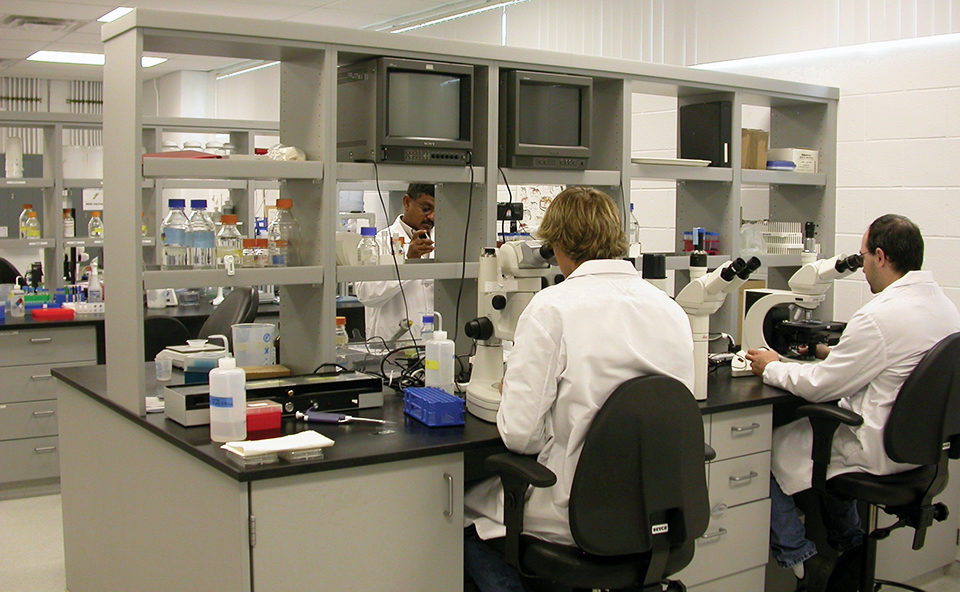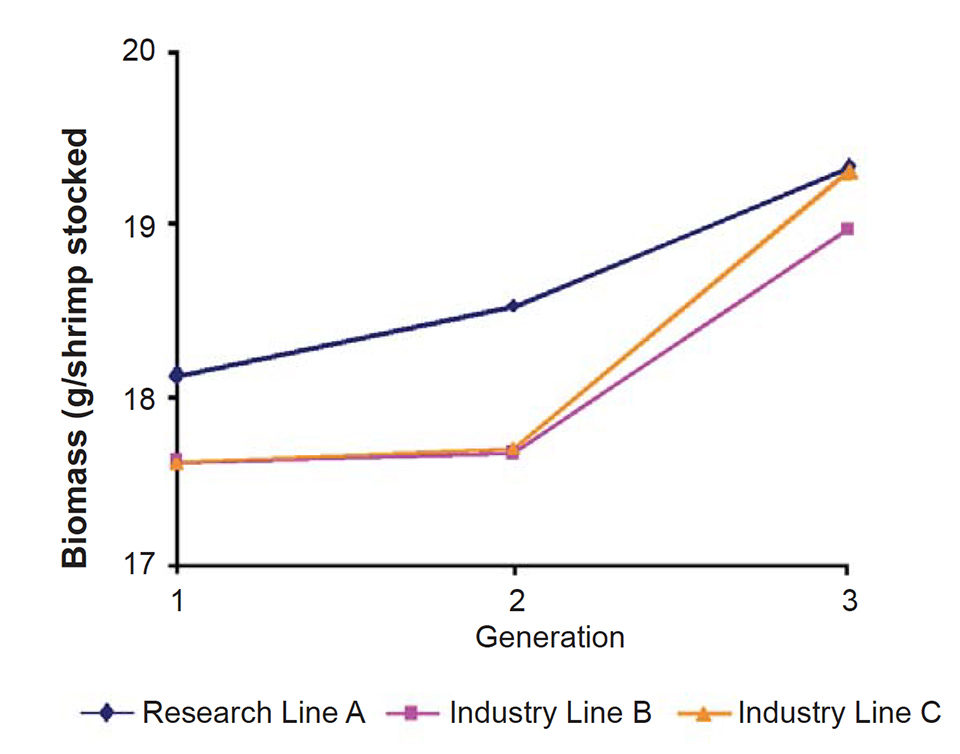Current focus is on improving growth, survival rates

The shrimp industry is on a path to become a mature industry in which, for the seed supply business, product differentiation will be based on the genetic value of the product, the health status, and phenotypic product quality. Shrimp farmers need to improve their management practices to exploit the potential value of the genetically improved seed.
Improved traits
Shrimp breeding for different production systems involves the application of principles of genetics and the use of relevant information from carefully designed experiments. The current focus in shrimp breeding is primarily on improving traits such as growth and survival rates.
Biosecure, zero-water-exchange shrimp production is based on the concept that shrimp viruses and other diseases can be excluded through the use of specific pathogen-free (SPF) stock and adequate biosecurity protocols. For more traditional pond systems, it is important that the shrimp have an inherent resistance to important diseases.
Shrimp families need to be tested for disease resistance, with core line development taking place in state-of-the-art nucleus farms. The commercial product, produced under SPF conditions, needs specific pathogen resistance to cope with disease challenges under commercial conditions.
Genetic progress
Fig. 1 illustrates the genetic progress accomplished for shrimp biomass harvested in three shrimp lines bred by SyAqua in the context of the ATP BioZEST project. Harvested biomass is the real trait of interest for farmers, since it combines harvest weight and survival. It is expressed here as g shrimp harvested per shrimp stocked.

During the course of two generations of selection, average genetic improvement rates per generation were 0.64 grams for harvest weight (about 3.2 percent of the mean/generation), 2.8 percent for survival (about 3.9 percent of the mean/generation), and 0.71 grams harvested/shrimp stocked for biomass (about 5.1 percent of the mean/generation). These values seem small, but for a production module of ten 500-square-meter raceways, each stocked with 500 shrimp per square meter, this genetic improvement represents an additional 3.5 metric tons (MT) of shrimp harvested in every production cycle.
Biomass improvement
So, with 240 families per generation, a generation interval of 12 months, and between-family selection for growth rate and survival, biomass (growth x survival) can be increased at an annual rate of about 5 percent. However, the rate of improvement for biomass will go down if the animals are also selected for specific disease resistance and robustness.
On the other hand, the program can be improved with the addition of within-family selection, a shorter generation interval, and marker-assisted selection. Combining these two arguments, the prediction is to achieve a 5 percent biomass increase per year, and make improvements in disease resistance and robustness, as well.
Other traits
In the future, traits of interest to other components of the shrimp production chain – processors, retailers, and consumers – will also need to be subjected to routine genetic improvement. Such traits include final product yield and quality, percentage of tail, and percentage of raw and cooked shrimp meat.
Some shrimp meat quality parameters may be of interest to consumers, such as polyunsaturated fatty acid (omega-3 and omega-6) content, fat content, and raw and cooked shrimp color. Feed-conversion efficiency will be another trait of interest in the future, and more focus will likely fall on shrimp aggression and feeding behaviors.
Quantitative genetics research has enabled us to precisely quantify the levels of GxE interaction for different shrimp production traits. Environmental factors such as stocking density, salinity, temperature, diet, water quality, and stress levels have been studied. With this detailed knowledge, effective breeding systems can be implemented for continued line development in various production systems.
Molecular programs
A molecular program can complement the core quantitative genetics and breeding strategies outlined above. Primary focus would be on marker development for disease resistance, product quality, and other traits. Markers can be valuable in the genetic improvement of traits that are difficult to improve by classical means.
Breeding companies need to focus on the collection of good phenotype data and samples for DNA extraction. In a few years, many more single nucleotide polymorphisms (SNPs) will be in the public domain, and service providers will be able to do the genotyping at low cost. SNPs are DNA sequence variations that occur when a single nucleotide in the genome sequence is changed. This happens about once every 100 to 300 bases.

Value, sustainability
The value of genetic improvement for the breeding industry and shrimp producers can be illustrated with the data in Table 1. Small increases in growth (harvest weight), survival, and pricing result in a U.S. $4 profit increase/thousand postlarvae stocked. This value could be partly retained by the breeding industry through increased genetic margin, while the remainder could benefit producers.
Steen, Relative value of genetic improvement, Table 1
| Parameter | Base | Increase | Improved | Increase |
|---|
Parameter | Base | Increase | Improved | Increase |
|---|---|---|---|---|
| PL price/1,000 | $2.00 | $2.00 | ||
| Harvest Weight (g) | 18 | 3% | 18.54 | |
| Survival | 0.70 | 3% | .072 | |
| Biomass (kg) | 12.6 | 13.37 | 6% | |
| Price/kg | $5.00 | 2% | $5.10 | |
| Revenue | $63.00 | $68.17 | 8% | |
| Extra feed costs | $1.15 | |||
| Increase of customer profit or genetic margin | $4.02 | |||
| Value extraction | 30% | $1.21 | ||
| New PL price/1,000 | $2.00 | $3.21 | 60% |
In spite of these opportunities, the shrimp-breeding industry has been volatile. One of the main challenges is to develop sustainable breeding practices based on rigorous implementation of well-designed breeding programs, a demonstration of genetic progress at the customer level, and genetic protection.
(Editor’s Note: This article was originally published in the July/August 2006 print edition of the Global Aquaculture Advocate.)
Now that you've finished reading the article ...
… we hope you’ll consider supporting our mission to document the evolution of the global aquaculture industry and share our vast network of contributors’ expansive knowledge every week.
By becoming a Global Seafood Alliance member, you’re ensuring that all of the pre-competitive work we do through member benefits, resources and events can continue. Individual membership costs just $50 a year. GSA individual and corporate members receive complimentary access to a series of GOAL virtual events beginning in April. Join now.
Not a GSA member? Join us.
Author
-
Hein van der Steen
StoneBridge Breeding
The Gatehouse, Abbotwood
Evesham WR11 4NS United Kingdom
Tagged With
Related Posts

Health & Welfare
10 paths to low productivity and profitability with tilapia in sub-Saharan Africa
Tilapia culture in sub-Saharan Africa suffers from low productivity and profitability. A comprehensive management approach is needed to address the root causes.

Responsibility
A helping hand to lend: UK aquaculture seeks to broaden its horizons
Aquaculture is an essential contributor to the world food security challenge, and every stakeholder has a role to play in the sector’s evolution, delegates were told at the recent Aquaculture’s Global Outlook: Embracing Internationality seminar in Edinburgh, Scotland.

Innovation & Investment
AI platform delivers data to fish and shrimp farmers
XpertSea does more than count fish. It uses AI and computer vision to calculate growth rates and optimal harvest dates to improve aquaculture efficiency.

Health & Welfare
Achotines laboratory home to continuing studies of tuna early life history
The Inter-American Tropical Tuna Commission Achotines Laboratory in southern Panama is the world’s only facility with nearly year-round availability of tuna eggs and larvae. A study is comparing the reproductive biology, genetics and early life history of yellowfin and Pacific bluefin tuna.


